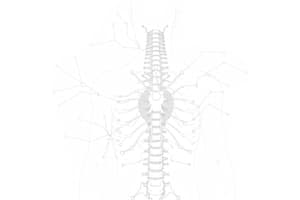Podcast
Questions and Answers
What is the function of the spinal cord?
What is the function of the spinal cord?
- Transmits messages between the brain and the body
- Controls reflexes such as heart rate and blood pressure
- Enables voluntary movements like walking and running
- All of the above (correct)
Complete injuries result in partial loss of motor and sensory function below the level of injury.
Complete injuries result in partial loss of motor and sensory function below the level of injury.
False (B)
What is the condition characterized by narrowing of the spinal canal?
What is the condition characterized by narrowing of the spinal canal?
spinal stenosis
___ transmit sensory information from the body to the spinal cord.
___ transmit sensory information from the body to the spinal cord.
Match the spinal cord injury effects with their descriptions:
Match the spinal cord injury effects with their descriptions:
Flashcards are hidden until you start studying
Study Notes
Anatomy
- The spinal cord is a long, thin, tube-like structure extending from the base of the brain down to the lower back
- Protected by the vertebral column and meninges (three layers of protective membranes)
- Divided into 31 segments, each corresponding to a specific region of the body
- Length: approximately 45 cm (18 inches) in adults
- Diameter: approximately 1-1.5 cm (0.4-0.6 inches)
Injuries
- Traumatic injuries: caused by physical trauma, such as car accidents, falls, or sports injuries
- Non-traumatic injuries: caused by non-physical factors, such as infection, cancer, or inflammation
- Types of spinal cord injuries:
- Complete injury: complete loss of motor and sensory function below the level of injury
- Incomplete injury: partial loss of motor and sensory function below the level of injury
- Effects of spinal cord injury:
- Paralysis or weakness
- Loss of sensation
- Bladder and bowel dysfunction
- Respiratory problems
Diseases
- Infections:
- Meningitis: inflammation of the meninges
- Abscesses: pockets of infected material that can compress the spinal cord
- Degenerative conditions:
- Spinal stenosis: narrowing of the spinal canal
- Spondylosis: degeneration of the spine
- Autoimmune disorders:
- Multiple sclerosis: demyelination of nerve fibers
- Transverse myelitis: inflammation of the spinal cord
- Tumors:
- Primary tumors: originate in the spinal cord
- Metastatic tumors: spread from other parts of the body
Function
- Transmits messages between the brain and the rest of the body
- Interprets and integrates sensory information from the body
- Controls reflexes and automatic functions, such as:
- Heart rate
- Blood pressure
- Breathing
- Bladder and bowel function
- Enables voluntary movements, such as:
- Walking
- Running
- Writing
Nerve Roots
- 31 pairs of nerve roots emerge from the spinal cord, each corresponding to a specific segment
- Divided into:
- Dorsal roots: transmit sensory information from the body to the spinal cord
- Ventral roots: transmit motor signals from the spinal cord to the body
- Nerve roots can be damaged by injury or disease, leading to numbness, weakness, or paralysis in specific areas of the body
Anatomy
- Spinal cord is a long, thin, tube-like structure extending from the base of the brain down to the lower back, protected by the vertebral column and meninges
- Meninges consist of three layers of protective membranes
- Divided into 31 segments, each corresponding to a specific region of the body
- Measures approximately 45 cm (18 inches) in length and 1-1.5 cm (0.4-0.6 inches) in diameter in adults
Injuries
- Traumatic injuries occur due to physical trauma, such as car accidents, falls, or sports injuries
- Non-traumatic injuries occur due to non-physical factors, such as infection, cancer, or inflammation
- Complete injury results in complete loss of motor and sensory function below the level of injury
- Incomplete injury results in partial loss of motor and sensory function below the level of injury
- Spinal cord injury may cause paralysis or weakness, loss of sensation, bladder and bowel dysfunction, and respiratory problems
Diseases
- Meningitis is an infection that causes inflammation of the meninges
- Abscesses are pockets of infected material that can compress the spinal cord
- Spinal stenosis is a degenerative condition that causes narrowing of the spinal canal
- Spondylosis is a degenerative condition that causes degeneration of the spine
- Multiple sclerosis is an autoimmune disorder that causes demyelination of nerve fibers
- Transverse myelitis is an autoimmune disorder that causes inflammation of the spinal cord
- Primary tumors originate in the spinal cord, while metastatic tumors spread from other parts of the body
Function
- Spinal cord transmits messages between the brain and the rest of the body
- Interprets and integrates sensory information from the body
- Controls reflexes and automatic functions, such as heart rate, blood pressure, breathing, and bladder and bowel function
- Enables voluntary movements, such as walking, running, and writing
Nerve Roots
- 31 pairs of nerve roots emerge from the spinal cord, each corresponding to a specific segment
- Dorsal roots transmit sensory information from the body to the spinal cord
- Ventral roots transmit motor signals from the spinal cord to the body
- Nerve roots can be damaged by injury or disease, leading to numbness, weakness, or paralysis in specific areas of the body
Studying That Suits You
Use AI to generate personalized quizzes and flashcards to suit your learning preferences.




